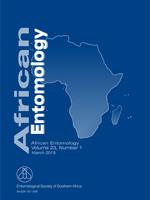The objective of this study was to evaluate the ability of two Beauveria bassiana isolates and one Paecilomyces sp. isolate to infect Nezara viridula adults under laboratory conditions. The lethal concentrations (LC50) of the Egyptian and exotic Beauveria and Paecilomyces isolates for N. viridula were 323 × 106, 835 × 106 and 281 × 107 conidia/ml, respectively. Although, there was no significant difference observed in the mortality rates of adults exposed to the conidiospores of the fungal isolates, the results demonstrated a concentration-dependent pattern. The conidia showed limited attachment to the insect integument. Interestingly, a positive relationship was observed between the rate of increase in the germination of conidia and that of the exposure time, up to 84–92 % at 48 h post-infection. Furthermore, germination of the isolates on the wings was significantly different. The conidia gave rise to germ tubes at 12 h with bipolar germ tubes and hyphal network at 48 h post-infection. SEM revealed that the Egyptian Beauveria strain damaged both the epicuticle and procuticle at 72 h post-infection with tube penetration in the cuticle and epidermis of both the exotic Beauveria- and Paecilomyces-infected bugs. Many changes were recorded in the cuticular phenoloxidase, fatty acids and hydrocarbons following fungal infection. These results induce direct relationship between the changes in the cuticular composition and the attachment/ germination of the entomopathogenic fungi. These data provide useful information with regard to the applicability of entomopathogenic fungi against N. viridula.
How to translate text using browser tools
1 March 2015
Nezara viridula (Hemiptera: Pentatomidae) Cuticle as a Barrier for Beauveria bassiana and Paecilomyces sp. Infection
I. Raafat,
W.S. Meshrif,
E.M. El Husseiny,
M. El-Hariry,
A.I. Seif
ACCESS THE FULL ARTICLE
It is not available for individual sale.
This article is only available to subscribers.
It is not available for individual sale.
It is not available for individual sale.

African Entomology
Vol. 23 • No. 1
March 2015
Vol. 23 • No. 1
March 2015
cuticular lipids
entomopathogenic fungi
green stink bug
infection




